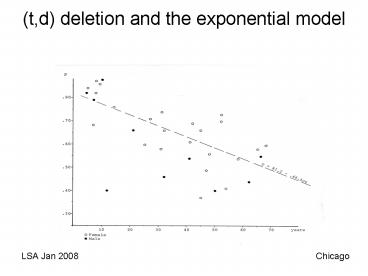t,d deletion and the exponential model - PowerPoint PPT Presentation
1 / 17
Title:
t,d deletion and the exponential model
Description:
what are probabilities attached to? an issue of interest to discusions of exemplar theory ... t,d - / -str cons [ cons] __ ## -syl ... – PowerPoint PPT presentation
Number of Views:67
Avg rating:3.0/5.0
Title: t,d deletion and the exponential model
1
(t,d) deletion and the exponential model
some observations by Bill Labov
LSA Jan 2008 Chicago
2
Grammatical conditioning of -t,d deletion
Introduces two main issues what are
probabilities attached to? an issue of interest
to discusions of exemplar theory are there
derivational stages between input and output? a
central issue in discussions of optimality
theory
3
Lexically regular variation coronal
stop deletion in English. Two
basic constraints on the simplification of /t,d/
clusters in English the effect of a following
consonant vs. a following vowel (a vs. b) and the
effect of grammatical boundary (c vs. d)
t,d -gt ltØgt / lt-strgt ltconsgt cons ltØgt __
lt-sylgt
4
Internal constraints on -t,d deletion for 11
speakers of AAVE Table 3.7 of 3288 Report,
Labov, Cohen, Robins Lewis 1968
KD before consonant mm
monomorphemic KV before vowel am
ambiguous p past
5
Extracts from the 1968 discussion of the
intermediate values for the ambiguous classes
We noted that the ambiguous boundaries of
kept, told, had less effect than a full
inflectional boundary such as lived, worked. .
. . Only after the alternations keep kep-,
tell tol- are learned can one recognize the
morpheme boundary . This is a situation typical
of derivational boundaries. . . We therefore
regard the two boundaries as related by the
degree of transparency of analysis required.
--Labov, Cohen, Robins Lewis 1968, Vol. 1, p.
136.
6
The English distinction between derivational and
inflectional morphology
Derivational Inflectional (Level
1) (Level 2) -tion, -al, -y -s,
-ed Productivity Low High Semantics Irregular R
egular Position Next to root Final Effect on
stem Frequent None Further additions Open Closed
Assimilation Regressive Progressive
7
In language learning, what are probabilities
matched to? A question of interest for exemplar
theory
If p is the probability of deletion of the final
obstruent in kept, left, told, etc.
Vb dP Vb 0P
Nodes
1-px px
kept kep
left lef
told tol
Words
1-px px
1-py py
1-pz pz
8
-t,d deletion probabilities for Curt and Kay C.,
King of Prussia
fist, hand, cold lost, kept, told
tossed, rolled
9
Probability matching of David C., 7 years old,
King of Prussia PA
fist, hand, cold lost, kept, told
tossed, rolled
10
Probability matching of 16 children, 3-5 years
old, So. Philadelphia. Source Figure 7.4,
Roberts 1994
fist, hand, cold lost, kept, told
tossed, rolled
11
Probability of t/d deletion in final clusters of
semiweak verbs (kept, told, lost, etc.) by
speaker age. (Guy Boyd 1990)
Conclusion As they age, speakers learn that the
final t.d with semiweak verb is analyzable as a
past tense morpheme.
12
Derivation of complex codas by internal structure
Mono- Derivational Inflectional morphemic
bold told rolled bowldN
telVdV rowlVdV Variable -t,d
deletion bowl(d)N telVdV rowlVdV
Bracket erasure bowldN teldV rowldV
Ablaut bowldN towldV rowldV Variab
le -t,d deletion bowl(d)N towl(d)V rowld
V Bracket erasure bowldN towld V rowl
dV Variable -t,d deletion bowl(d)N towl(d)V
rowl(d)V Bracket erasure bowld towld rowld Post
lexical bowl(d) manNP towl(d)
miyVP rowl(d) farVP
13
Observed rates of retention Preterit Derivatl
Monomorphemic rolled told bold N 108 53 45
6 Retained 86 39 242 Rate 79.63 73.58 53.07
Estimated true rate of retention for
P for D for M P P2 P3 0.79 0.624 0.493
0.80 0.640 0.512 0.81 0.656 0.531 0.82
0.672 0.551 0.83 0.689 0.572
14
Observed rates of retention Preterit Derivatl
Monomorphemic rolled told bold N 108 53 45
6 Retained 86 39 242 Rate 79.63 73.58 53.07
Predicted retentions P 108P 53P2 456P
3 0.79 85.32 33.08 224.83 0.80 86.4 33.92 233.4
7 0.81 87.48 34.77 242.34 0.82 88.56 35.64 251.4
2 0.83 89.64 36.51 260.73
15
Observed retentions 86 39 242 Predicted
retentions 85.32 33.08 224.83 (86 -
85.32)2/85.32 .005
16
Preterit Deriva- Mono- Best Fit
Chi-sq prob tional morphemic pr 1991
N 100 53 539 Retained 79 29 221 Estimated
pr 0.79 0.73 0.74 0.74 0.37 0.94 1992
N 116 64 583 Retained 93 32 250 Estimated
pr 0.80 0.71 0.75 0.75 0.93 0.82 1995
N 404 229 922 Retained 323 149 496
Estimated pr 0.80 .80 0.81 0.82 0.67 0.88 1996
N 96 82 374 Retained 85 62 219 Estimated
pr 0.88 0.87 0.84 0.84 0.56 0.91 1997
N 258 90 906 Retained 209 71 491 Estmated
pr 0.81 0.89 0.82 0.82 1.99 0.57 2001
N 108 53 456 Retained 86 39 242 Estimated
pr .79 .85 .81 0.81 0.539 0.91
17
(t,d) deletion by following segment, ethnicity
and gender





























